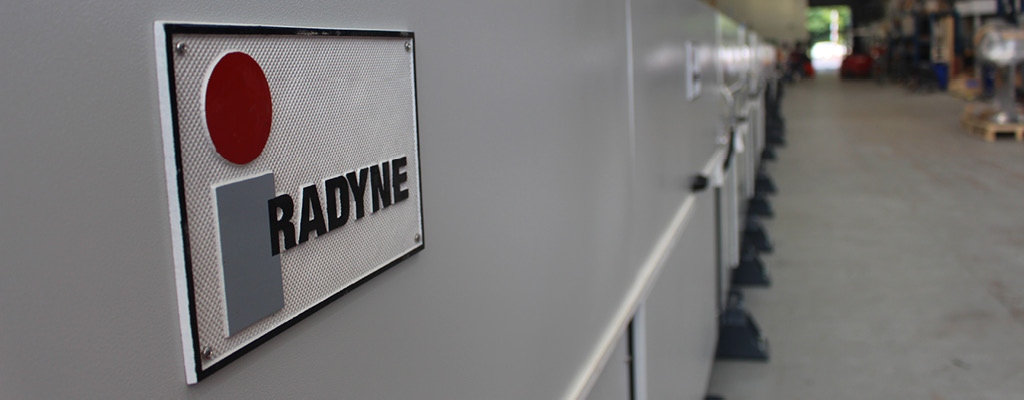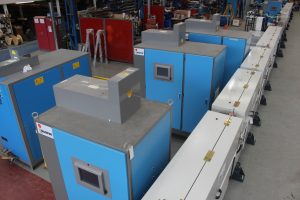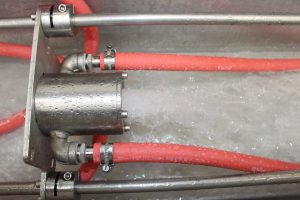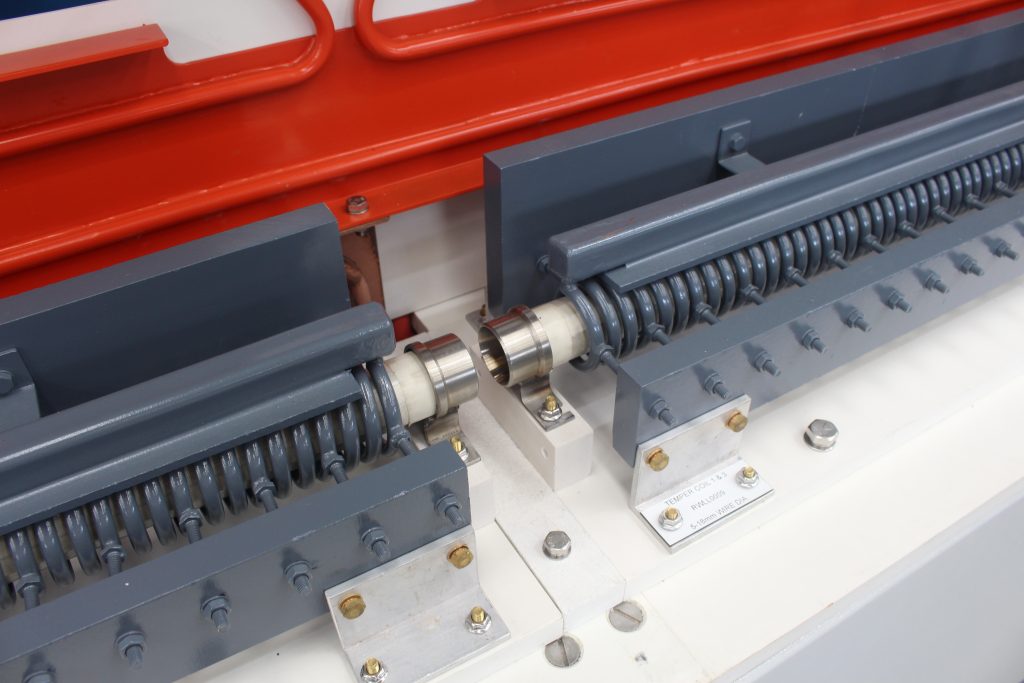
By Shawn Martin
Introduction
Radyne spring wire induction temper (IT) lines are revolutionizing the spring wire industry. Traditional methods of hardening and tempering spring wire have proven shortcomings. The Radyne IT line is highly automated, runs continuously, provides for increased throughput and contains an environmentally friendly water quenching medium. These factors combined mean high strength spring wire with greater consistency for the end user.
What is spring wire and how is it used in the world?
Spring wire is a common name given to a range of steel wires prominently used in the manufacture of industrial and automotive springs. Inclusive of low-alloy manganese, medium-carbon and high-carbon steel wires, spring wire is a hardened and tempered steel alloy with exceptional yield strength. Other materials are incapable of undergoing deformation without losing their parent shape. Spring wire differs as it retains its physical shape after undergoing an appreciable amount of strain. It is an inherently resilient material with excellent elastic behavior.
How is spring wire important to businesses or consumers?
Businesses and consumers require spring wire for numerous applications including general mechanical springs, automotive suspension systems, garage door springs, automotive engine valves and even aircraft engines. Higher strength spring wire with a greater reduction of area not only increases the fatigue rate and life expectancy of these end-use products, it also supports cold coiling processes as additional heat treatments are not performed after cold coiling.
What are the current methods of manufacture?
Traditional methods of manufacturing springs involve heating discrete lengths of wire in a furnace, up to temperatures in the region of 1000° C. The hot wire is wrapped around a mandrel to create the wound spring. While the wire is still hot, it slides free of the mandrel and drops into an oil quench tank in which the steel hardens. After exiting the quench tank, the hardened spring is tempered, possibly in a batch furnace.
Recently, oil tempering (OT) has been developed as a continuous process. This involves heating the wire through a very long furnace which is either gas fired or electrically heated. The wire is then passed through an in-line oil quench tank, hardening the steel. Subsequently, the wire then runs through a tempering zone. Typically, this requires the use of molten lead baths. OT lines are not without their intrinsic operational and environmental issues.
What are the main challenges with spring wire production?
Traditional methods of hardening and tempering high carbon spring wire have inherent limitations. The consistency of mechanical properties achieved through the heat treatment process is jeopardized by direct fired heating methods. This is because it is increasingly difficult to maintain target temperatures. There are also additional costs associated with the handling and disposal of quench oil. Environmental regulations limit NOx and SOx emissions, require pollution control devices and impose permitting fees as higher operating efficiencies are mandated. Direct heating and lead baths also introduce contaminants and the finished product typically requires additional heat treatment after it has been formed into an end-use product.
What is IHW’s solution?
Radyne spring wire IT lines harden and temper high carbon spring steels such as SAE 9254, achieving a tensile strength of 2000 MPa with a reduction of area greater than 40%. The innovative modular system runs at a continuous line speed of up to 165 m per minute for 7 mm spring wire and up to 28 m per minute at 17 mm. Throughput capacity can reach up to 3 tons an hour. 1.5 and 2 ton variations are also available, thus providing even more flexibility to our customers.
The Radyne solution is backed by a guarantee that covers dimensional distortions, surface finish, defects, ultimate tensile strength and consistency. It addresses problems associated with traditional processing methods as it runs continuously but efficiently. The inclusion of an environmentally clean water-quenching system helps mitigate the regulations surrounding spring wire production. This system produces a wire with a consistently high tensile strength. Produced spring wire is readily used for cold coiling into a finished product, eliminating the need for additional heat treatment.
Radyne spring wire IT lines
Radyne spring wire IT lines are composed of a closed loop handling system, inline drawing blocks, industry leading induction heaters, environmentally clean water quenching systems and a highly modular and automated PLC with decentralized communication modules. The system maintains preset specifications at each stage of the hardening and tempering line to produce highly uniform spring wire with unprecedented strength and hardness consistency. The system accommodates a wire diameter range of 7 mm to 17 mm with a throughput capacity of up to 3 tons per hour across all diameter sizes.
Mechanical handling unit
The payload used to feed the spring wire IT line undergoes a series of treatments. The associated mechanical handling unit of the Radyne spring wire IT line acts to straighten, draw, brush and wash the wire. Operators simply butt-weld adjoining coils of the payload to supply a continuous feed to the line. Advanced PLCs maintain tension without necking or any undesired deformation. The handling unit includes:
- Rotating pay-off with integral dancing arm and damper.
- Automated pinch roll and straightening module.
- Advanced PLCs and associated handling systems eliminate plastic deformation throughout the quench and temper process.

Induction hardening
Induction hardening uses multiple induction heating coils to ensure product quality. The first section elevates the temperature of the wire from ambient to the curie temperature, approximately 700° C. The post-curie section further elevates wire temperature to a suitable hardening temperature. This is followed by a smaller induction unit that equalizes the target temperature from the wire’s surface through its core, alleviating any residual stress. The process allows the wire to undergo an allotropic phase transformation (i.e., a metallurgical change in the metal).
The system uses the Radyne TFi IGBT inverters, which are the power workhorses for the IT lines. The TFIs are highly reliable and provide fast response and high heating rates that work in harmony with the induction heating coils. They provide heating capacities up to 560 kW, with a nominal output frequency of 10 kHz to 50 kHz.
Optical pyrometers inspect wire temperature, ensuring a highly uniform thermal profile of the wire surface.

Water quenching
The water quenching system consists of a 6 m trough of filtered, circulated and temperature-regulated water. The system does not contain any oils or polymers, thereby eliminating pollution and combustion concerns, and disposal costs of quench oils. This ensures that it is a fast, environmentally friendly and effective solution with cost-saving advantages.
- It achieves a martensitic structure with a Rockwell hardness in the region of 62 Rc.
- It minimizes potential for quench cracking.
- The entire wire length experiences consistent quench parameters.
Induction tempering
After the phase transition, the wire is induction tempered. The hardened steel wire is induction heated from ambient to 450°C. A second series of induction circuits equalize the thermal profile through to the core of the spring wire. These induction coils are powered using Radyne Flexitune IGBT power supplies, which are used to match process requirements and ensure temperature equalization. The hot, tempered wire is quenched again to enable mechanical handling. A thin protective oil film is applied to the finished wire to inhibit corrosion.
Eddy current sensors automatically locate and shear off the butt-welded joints before the wire is collected on the take-up windmills.

Advanced controls
The spring wire IT line is monitored and controlled by a modular and automated PLC system with decentralized communication modules. This includes an advanced digital control system utilizing Dual Core ARM Processors. Monitors and controls are used for the pinch roller tension, mechanical drives, line speed and power output to induction coils.
Materials and advanced capabilities
Cold coiled processing of the produced spring wire allows manufacturers to form complex shapes and geometries such as concave springs, convex springs and other non-parallel geometries. Such geometries far exceed the capabilities of traditional manufacturing. The spring wire IT line can process a wide range of carbon steels and exotic alloys.
- High carbon steel
- Silicone alloyed steel
- Chromium alloyed steel
- Vanadium alloyed steel
Conclusion
The Radyne spring wire IT line produces a defect-free, hardened and tempered spring wire with guaranteed consistency of strength and reduction of area and hardness.
Manufacturers benefit from increased production capacity, higher yield rates, greater manufacturing flexibility and an eco-friendly quenching medium. The Radyne system supports the trend toward cold coiled processing thus allowing manufacturers to produce complex shapes and geometries for numerous end-use applications including automotive suspension springs, garage door springs and general mechanical springs.




